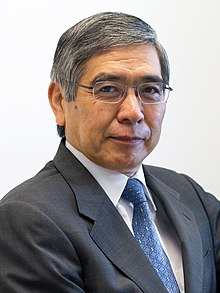Bank of Japan
|
|||
| Headquarters | Chūō, Tokyo, Japan | ||
|---|---|---|---|
| Coordinates | 35°41′10″N 139°46′17″E / 35.6861°N 139.7715°E | ||
| Established | June 27, 1882 / October 10, 1882 | ||
| Governor | Haruhiko Kuroda | ||
| Central bank of | Japan | ||
| Currency |
Japanese yen JPY (ISO 4217) |
||
| Bank rate | 0%-0.10% | ||
| Website | www.boj.or.jp | ||
| Governor of the Bank of Japan | |
|---|---|
| Style | His Excellency |
| Appointer | Prime Minister |
| Term length | Five years |
| Inaugural holder | Yoshihara Shigetoshi |
| Formation | October 6, 1882 |
The Bank of Japan (日本銀行 Nippon Ginkō?, BOJ, JASDAQ: ) is the central bank of Japan. The Bank is often called Nichigin (日銀?) for short. It has its headquarters in Chūō, Tokyo.
Like most modern Japanese institutions, the Bank of Japan was founded after the Meiji Restoration. Prior to the Restoration, Japan's feudal fiefs all issued their own money, hansatsu, in an array of incompatible denominations, but the New Currency Act of Meiji 4 (1871) did away with these and established the yen as the new decimal currency, which had parity with the Mexican silver dollar. The former han (fiefs) became prefectures and their mints became private chartered banks which, however, initially retained the right to print money. For a time both the central government and these so-called "national" banks issued money. A period of unanticipated consequences was ended when the Bank of Japan was founded in Meiji 15 (October 10, 1882), under the Bank of Japan Act 1882 (June 27, 1882), after a Belgian model. It has since been partly privately owned (its stock is traded over the counter, hence the stock number). A number of modifications based on other national banks were encompassed within the regulations under which the bank was founded. The institution was given a monopoly on controlling the money supply in 1884, but it would be another 20 years before the previously issued notes were retired.
...
Wikipedia



